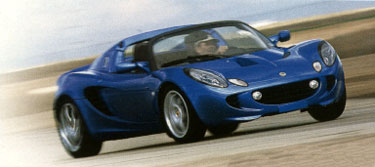This was excerpted from an article about handling, published in the June, 2002 issue of Road and Track.

Lotus Elise Roat Test for Road and Track
Rank: 2nd
The Lotus Elise epitomizes Colin Chapman's minimalist philosophy of the lightweight, excellent-handling sports car. It is built with fiberglass body panels attached to an all-aluminum space-frame chassis. Our European-spec test car came with a Rover 1.8-liter inline-4 powerplant transversely mounted behind the cockpit for optimal cornering balance. Extending out to all four comers are upper and lower A-arm suspensions riding on front 175/55R-16 and rear 225/45R-17 tires. Sporting a modest 122 bhp and 124 lb.-ft. of torque, the Elise still scoots up to speed quickly, thanks to a light 1900-lb. test weight. And like the Mitsubishi Evolution VII, this roadster is scheduled to arrive in the States soon, approximately late summer of 2003.
Through the lane-change exercise, our staff unanimously agrees that the Lotus's steering feels direct and immediate, and the car's balance is unflappable, thanks to a well-tuned suspension and a tremendous amount of rear grip. In objective performance tests, while the Corvette Z06 wins the skidpad and the Ferrari is the quickest through the hairpin, the Elise sweeps the remaining two categories: It absolutely dominates the slalom with a record-breaking average speed of 73.0 mph; and at 9.595 seconds, it's the fastest to complete the right/left transition lap segment. This means that this asphalt-clawing roadster suffers only from lack of power to adjust the car's attitude on the skidpad and accelerate out of the tight hairpin. Once at speed, it can generate the most lateral grip. Around the hairpin, the Lotus's apex speed of 40.4 mph is much faster than the Ferrari's 34.1 mph.
The first comment from Herta after lapping in the Lotus Elise: "This is a street legal race car. It feels very similar to a Formula Ford. The gearbox is very light and responsive. I would say it has mild understeer everywhere on the track. I can carry quite a lot of speed through the comers because of the car's grip. And since it doesn't have enough power, I just can't accelerate off the comer. The steering feels like it's directly connected to the wheels and you have your hands on the road while you are driving. You can really feel everything through it."
Some may argue that the Lotus Elise is not really a road car. We have to agree. It does have two seats and a radio, and these are really all the amenities it has. So driving the Elise as a daily runabout on the street is not practical. There is only enough room for the driver and passenger, and not much else. Call it the ringer for this best handling car competition.
(later)
Looking at performance data alone, the Lotus Elise walks away as the winner.
(later)
Ultimately, it is still the Ferrari excelling in all categories that helps t claim the top podium spot as Road and Track’s best-handling car.
Road and Track
June 2002
